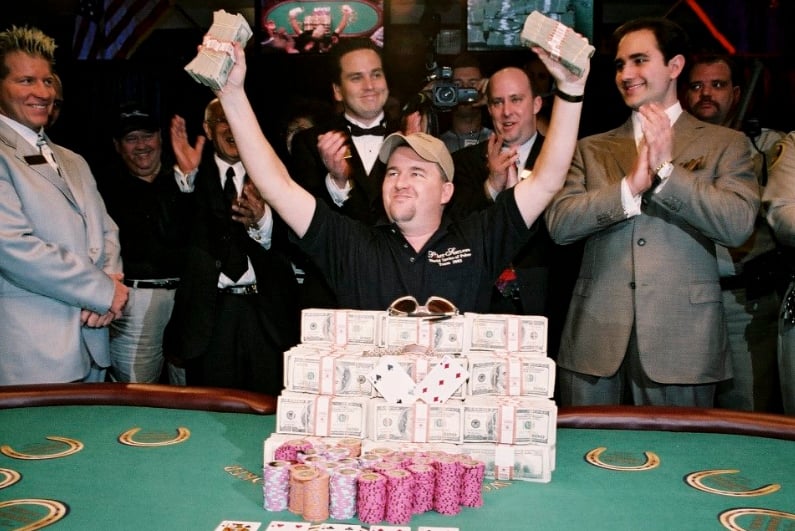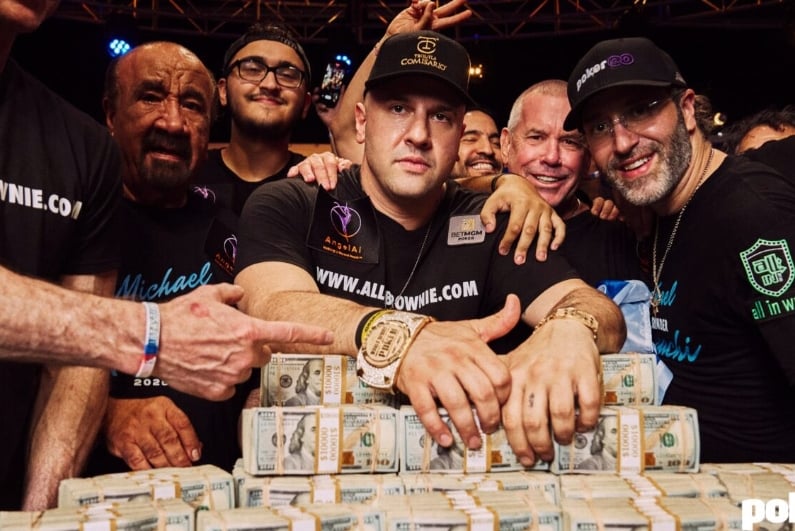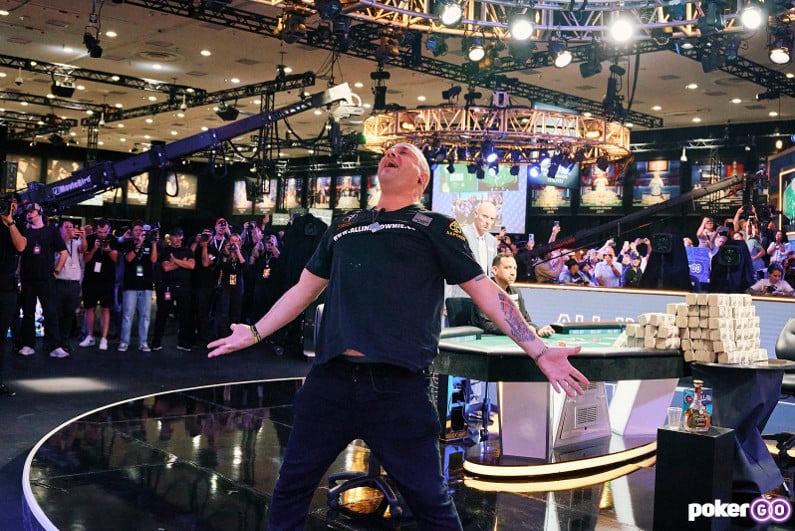Another schizophrenic interpretation
As I take my penultimate deep dive into an iconic hand, I am reminded of a comment from one of my readers who said that this series of articles don’t really know whether they are a “historical recount [or] strategy guide.” Much like their author, they do not know into which camp they best fit.
in writing as in law, clarity is king.”
He went on to say that “the line between author and strategist may be blurred, but it is [my] duty to define it. In the court of poker analysis, we cannot afford ambiguity. [My] inner turmoil may serve as inspiration, but in writing as in law, clarity is king.”
He is right, of course. However, I am nothing if not a contrarian so instead of heeding his wise words of advice, I shall not only plow on with another schizophrenic interpretation of a legendary poker hand but now, because I have incorporated his review of my confused hermeneutical approach, I have surely added another unnecessarily distracting post-modern element.
The 300
The greatest David vs Goliath battle in history was the Battle of Thermopylae, better known as the Battle of the 300. The Persian Emperor Xerxes led an army of 300,000, outnumbering the Greek army of 20,000. To give them some hope, the Athenian General Themistocles devised an innovative strategy, blocking off the Persian advance by land at the narrow pass of Thermopylae, and by sea at the Straits of Artemisium.
For two days, the Greek forces held off Xerxes as King Leonidas led a group of 300 fearless Spartan soldiers, blocking the only road by which the Persian army could advance into the Greek mainland. On the third day, a local by the name of Ephialtes informed Xerxes about an alternative pathway through the mountains that would bypass the Greek defensive position.
Realizing that the Persian forces were attempting to outflank his men, Leonidas convened a war council where he insisted that the majority of the Greek forces retreat and regroup for a later stand whilst he and the 300 would stay to hold off Xerxes’ army for as long as possible.
When their short swords broke, they engaged in hand to hand combat
The Spartans fought bravely versus tens of thousands of Persian soldiers. When their spears broke, they switched to their short swords. When their short swords broke, they engaged in hand to hand combat. Fighting down to the very last man, their sacrifice delayed the Persian horde enough for the remaining Greek forces time to retreat, regroup and reinforce for the next battle.
David versus Goliath
Poker had its own David vs Goliath clash in 2003. Heads-up for the World Series of Poker (WSOP) Main Event title, a Tennessee accountant with an implausibly perfect name, wearing a beige Pokerstars baseball cap and sunglasses was playing for $2.5m versus a veteran poker pro in a sharp suit, his shirt unbuttoned, an unlit cigarette hanging from his mouth.
Chris Moneymaker and Sammy Farha played arguably the most famous hand in the history of televized poker. Coined ‘The Bluff of the Century,’ it is said to have changed the course of poker history. In a hand that escalated quickly, Moneymaker was as brave as a Spartan warrior, pulling the trigger on an audacious bluff. His line was plausible and he had the courage of his conviction.
The gap between recreational and professional never seemed so small
Farha was rattled, put to the test by his relatively inexperienced opponent. Sitting at home, watching on their television sets, millions of poker players and fans were engrossed and, for the first time, many of them believed ‘that could be me.’ The gap between recreational and professional never seemed so small.
Farha runs deep in 2003
Born in 1959 in Beirut, Lebanon, Ihsan Farha grew up in his native country and lived there until he was 16 years old, when his family fled the country at the beginning of the civil war. They moved to the US where Ihsan started going under the name Sam. He earned a degree in business administration from the University of Kansas but he always had a passion for games. He played pool, pin ball, Pac-Man and, later on, poker.
In a poker era that rewarded aggression, Farha’s forceful temperament and uber-competitive nature paid dividends. He was a big winner in cash games but, in 1996, he decided to go to the WSOP. He won the $2,500 Pot-Limit Omaha event but despite the immediate success, a passion was not ignited for tournaments, which became an occasional diversion from the side game action that he craved.
there was one name, the peculiarly perfect name of a rank amateur that stood out
In 2003, he made a deep run in the WSOP Main Event alongside the likes of Phil Ivey, Marcel Luske, Dutch Boyd, David Grey, Bruno Fitousi, Howard Lederer, Freddy Deeb, Men Nguyen, David Singer and former champions Dan Harrington, Scotty Nguyen and Phil Hellmuth. A record breaking 839 entrants stumped up the $10,000 buy-in and, while it boiled down to a shark-filled endgame, there was one name, the peculiarly perfect name of a rank amateur that stood out.
Moneymaker makes the final table
Chris Moneymaker had absolutely no live tournament experience when he took his seat in the 2003 WSOP Main Event. He had won his way in via an $86 online satellite on Pokerstars and so, with virtually nothing to lose, he tangled with the world’s best. On the penultimate day, he spiked the river to eliminate Phil Ivey in 10th place, paving the way for an unlikely final table appearance.
Moneymaker had 28% of the chips in play but he had stiff competition in the form of Farha, Amir Vahedi, David Singer, Jason Lester and 1995 champion Dan Harrington. As some of the bigger names made way, commentators Lon McEachern and Norman Chad sensed that there was an upset on the cards. The question on everybody’s lips became ‘can Moneymaker do the inconceivable?’
When Lester and Harrington bust in fourth and third place respectively, the stage was set for Farha and Moneymaker. There was still a lot of poker to play and an enormous $1.2m difference between first and second place. Mano y mano, could the amateur hold his nerve? Was he capable of pulling the trigger on a big bluff if required?
The Hand
Pre-flop
The blinds were 20,000/40,000 with a 5K ante per player. Moneymaker had the chip-lead with a stack of 4.62m. Farha was not too far behind with 3.77m. Moneymaker raised to 100,000 on the button with K♠️ 7♥️ and Farha called with Q♠️ 9♥️.
Flop
With a pot of 210,000, the flop came 9♠️ 2♦️ 6♠️. Farha checked and Moneymaker checked back.
Turn
With the pot still at 210,000, the turn came the 8♠️. With top-pair and a medium strength flush draw, Farha decided to lead out for 300,000, a big over-bet of the pot. In response, Moneymaker raised to 800,000 with his combo-draw. Farha called.
River
With the pot having been bloated to 1.81m, the river came the 3♥️. Farha checked and Moneymaker went all-in for Farha’s effective stack of 2.8m, 1.55x times the pot. Farha tanked for a long time before eventually folding.
Analyzing the Bluff of the Century
Flop
The hand began with both players making standard pre-flop actions. On the flop, Farha should have no leads and Moneymaker should split between checks and bets.
Turn
On the turn, Farha’s decision to lead was good but his choice of sizing is way too large. A bet in the region of 75% would have achieved most of his desired objectives. In response, Moneymaker would be best served by calling as, with position, he had the correct implied odds and also could have been ahead of Farha’s semi-bluffs (J♠️T♥️, Q♠️J♥️ or J♣️7♣️).
NOTE: The one caveat I would add and an interesting thing to consider here is if Moneymaker thought of himself as an underdog, it was not a terrible strategy to bloat pots where he likely had good equity. While strategy pieces should rightly approach the hand from a theoretical point of view and not consider such things, it is a real world consideration that a player should factor in if they believe that they are up against a superior opponent.
Moneymaker can have a lot of draws, meaning Farha is winning now
Once Moneymaker raises, Farha has a clear call. He has top pair with a draw to the third nuts. The board is very wet and Moneymaker can have a lot of draws, meaning Farha is winning now. Even if Farha is behind, a spade, Queen or 9 could all make him the best hand.
River
The river is in all probability a brick (54 for a double bellybuster is a long shot possibility but it’s reasonable to discount it) so nothing has changed from the turn. Farha has to check to the aggressor.
Having missed all his draws, Moneymaker is a long shot to be good after Farha got sticky on the turn. He pulls the trigger on ‘the bluff of the century,’ putting Farha to the test for all his remaining chips. The bet is over 1.5x pot and with it, he polarizes himself to nuttish hands and bluffs.
The K♠️ in Moneymaker’s hand makes this a decent candidate as it blocks the second nuts. His sizing represents flushes and makes life difficult for a lot of Farha’s one-pair and two-pair hands.
Farha has a bluff-catcher. His hand doesn’t beat any value but it beats all the bluffs. Dara explains that from a game theory point of view, Farha has to decide if he has a good bluff-catcher.
having a spade is actually more important than having a second pair
In other words, he has to assess whether his cards have any additional value above and beyond his hand strength. The simple answer is that it does as the spade makes it a good bluff catch candidate. Given that one and two pair hands are of equal strength versus a polarized range, having a spade is actually more important than having a second pair (Q♠️ 9♥️ is a better call than 6♣️8♣️).
Farha has a must-call at equilibrium but he ultimately decides to let it go, perhaps believing that Moneymaker did not have it in him to bluff in such a high pressure spot. Had he made the required read on the river he would have delivered a body-blow to Moneymaker and taken an 8-1 chip lead. Instead, Moneymaker pulled in a pot of 3.72m chips, which helped propel him to victory.
The Moneymaker Effect
Following the Battle of Thermopylae, Greek land and naval forces pulled back from their previous positions and evacuated Athens. The retreat was however a tactical one, and eventually the Greeks landed a few decisive victories against Xerxes’ forces – primarily at the Battle of Plataea in 479 BC and at the naval Battle of Salamis the following year. These battles ultimately served to put an end to Xerxes’ invasion of Greece.
Shortly after his big bluff, Moneymaker got it in with 5♦️4♠️ on a flop of J♠️ 5♠️ 4♥️ versus Farha’s J♥️ T♦️. He had made a move when he needed to and now he got it in good. His hand held and was crowned the 2003 WSOP Main Event champion.
‘Moneymaker’ was the name that launched a million online poker accounts
Moneymaker’s bold play is an easy hand to romanticize and, in some ways, that makes it a harder one to analyze. It is part of poker folklore, a key moment on the way to a major victory that arguably triggered the poker boom. ‘Moneymaker’ was the name that launched a million online poker accounts and ‘The Moneymaker Effect’ made dreamers out of a new generation of poker players.
Check out #1, #2, and #3 in my list of iconic hands featuring Jamie Gold vs Paul Wasicka, Erik Seidel vs Johnny Chan, and Scotty Ngyen vs Kevin McBride.




